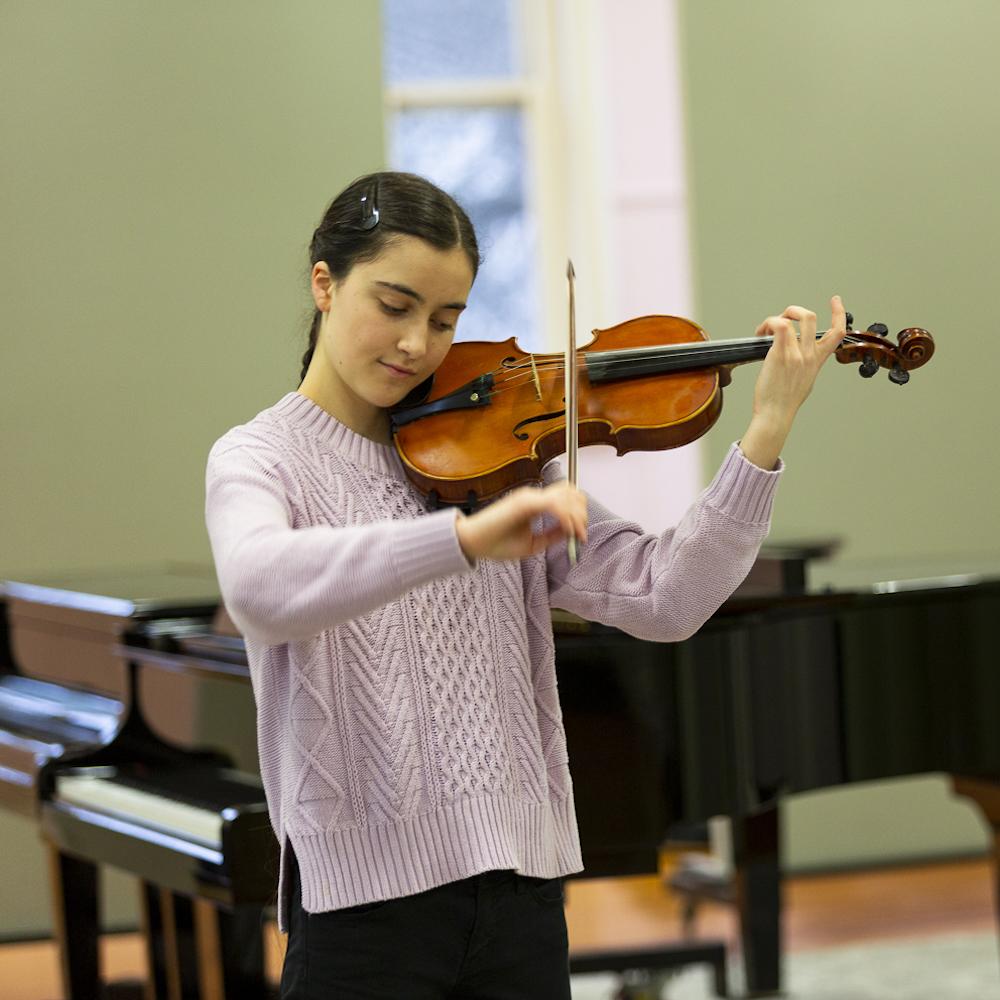Words by
Louise Turnbull (VIC) violin

Jessie Montgomery composed her Rhapsody no. 1 in 2014, as the first in an intended set of six works for solo violin. It was also the first work that Jessie had written for herself to play. This piece was inspired by the infamous Solo Sonatas of Eugene Ysaÿe, and I can particularly hear the influence of sections from the second and third of these sonatas in Jessie’s Rhapsody no. 1. This piece also makes use of a variety of extended techniques on the violin, demonstrating the composer’s intimate knowledge of the instrument. In learning this piece, I have attempted to bring out its rhapsodic nature, and to emphasise the various melodic features throughout. It has also been quite a challenge to develop the distinct characters within each section, and to find the direction and shape of each phrase. With a piece like this, I think it has been particularly valuable to have been able to do a number of practice performances too, as I have found that there are certain things within the work that feel very different whilst in a live performance setting, compared to how they feel in the practice room. There are also certain sections that almost require the performer to feel and respond to the acoustic and atmosphere of the room in the moment of performance, rather than to simply attempt to replicate a predetermined path for the music.
When I began learning this piece, I made the conscious decision to avoid listening to any recordings for the first few weeks, or until I had formed an independent view of the piece based on my own musical intuition and interpretation of the score. This was something that I had never previously committed to doing, and I was very interested in how this would affect my preparation process. I often found myself needing to think much harder about my musical decisions, without having the crutch of a recording to listen to, and possibly imitate, if I was unsure. I also found that I had to be more decisive in my musical choices, and that it was necessary to let go of doubts about whether what I had chosen to do musically was objectively 'correct' or not.
Using this methodology, I have come to understand more acutely that making informed decisions based on the available information about the work and my own individual musical sensibilities is incredibly important, rather than simply replicating what may seem to be the conventional way of playing various elements.
I feel that this process has allowed me to form a much deeper and more personal connection to the piece too. Upon finally listening to some recordings available online, I found I was able to experience the performances of the work in a distinctly different way compared to what I would have encountered during the earlier stages of my learning process. This newfound perspective allowed me to more greatly appreciate the unique nuances through which each performer had interpreted the score, which also served as a continuous source of inspiration for me. Though this approach to learning a new piece may not be practical in many cases, there are numerous things that I have learnt from this process that I am sure will inform and enhance my approach to learning music, both new and established, in the future.
I am very excited to be performing this piece as part of such a varied and eclectic program of works this week. I am lucky enough to also have some time with David Kim to workshop this piece, which I am very much looking forward to, and from which I will hopefully gain many valuable insights that will enhance the depth of my interpretation.
Hear Louise perform this work as part of:
DAVID KIM: VOODOO DOLLS
Sat 10 June 2023, 7pm
Rosina Auditorium, Abbotsford Convent
FIND OUT MORE
More from Louise about Jessie Montgomery's Rhapsody no. 1:
The Rhapsody begins with a chorale-like opening melody, which is interspersed with fleeting, gestural passages, before returning to a section of rich double stops. There is then a section of fluid, wandering semiquavers that lead to the climactic middle section marked con fuoco, or with fire. This section is written with passages of bariolage (changing from one string to another) and arpeggiated chords, which allow the violin to resonate to its fullest extent, and which I find very enjoyable and satisfying to play. At the pinnacle moment of the composition, the word 'wild!' is indicated in the score, as if to compel the performer to discover greater depth in their sound than they may have believed attainable at this juncture of the performance. There is then a passage of searingly dissonant seventh chords marked triple-forte, before the return of the opening chorale section section. After this, the performer is instructed to play the coda con sordino, with a mute, which gives the violin a hushed, slightly muffed tone. The phrase that is heard at this point is then repeated, this time with the indication to play it sul ponticello, meaning with the bow on top of the bridge, which makes the violin speak in a cracking whisper. There is a musical breath before the final two bars of the piece, which are in a louder dynamic, and refer back to the opening section. I like to think of these last bars as though they are the closing paragraph to a story that has been both exciting and emotive, and maybe a little wild, but that has eventually come to a peaceful conclusion.